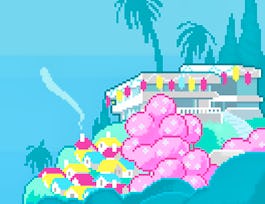Welcome! This course is an introduction to the primary concepts of gaming, and an exploration of how these basic concepts affect the way gamers interact with our games. In this course you will understand what defines a “game” and the mechanics and rules behind different types of games. Through four linked assignments you'll learn ways to create and describe a game concept, and specifically what makes a compelling game. This course focuses on the conceptual underpinnings of games, and all assignments can be completed with a pencil and paper – no previous programming knowledge is required.


Introduction to Game Design
This course is part of Game Design: Art and Concepts Specialization
Taught in English
Some content may not be translated

Instructor: Fran Krause
111,887 already enrolled
Included with 
Course
(2,755 reviews)
98%
Skills you'll gain
Details to know

Add to your LinkedIn profile
Course
(2,755 reviews)
98%
See how employees at top companies are mastering in-demand skills

Build your subject-matter expertise
- Learn new concepts from industry experts
- Gain a foundational understanding of a subject or tool
- Develop job-relevant skills with hands-on projects
- Earn a shareable career certificate


Earn a career certificate
Add this credential to your LinkedIn profile, resume, or CV
Share it on social media and in your performance review

There are 4 modules in this course
This week we start at the beginning: what are the principles of very simple games, like Hangman and tic-tac-toe? How do these games work? Why do people play them? What are the elements that define games and the gaming experience? And finally, what do games have in common with each other, and what sets them apart? In addition to covering the basics and ground rules for this course, we'll conclude this week with a very simple, low-tech assignment: create a game on a single sheet of paper.
What's included
6 videos5 readings1 peer review1 discussion prompt
How does a player learn the mechanics of your game? How do they learn anything about your game? This week we will talk about the rules that define gameplay, and how those rules are communicated to your players. We also discuss the way rules are bent and broken by players.
What's included
6 videos1 peer review
How does narrative drive a player to start playing your game? Or to finish it? This week we'll look at some of the ways you can make your game more compelling with story, and discuss some of the ways story can drive gameplay forward, or enable a player to make their own way through it.
What's included
9 videos1 peer review
What purpose does an enemy serve in a game? What effect does a second player have on two-player games? Can a game work without an adversary or a final goal? We'll address all of those questions in this last week of the class, and work towards finalizing your board game project with characters.
What's included
6 videos1 reading1 peer review
Instructor

Offered by
Recommended if you're interested in Music and Art

California Institute of the Arts

California Institute of the Arts

California Institute of the Arts

California Institute of the Arts
Why people choose Coursera for their career




Learner reviews
Showing 3 of 2755
2,755 reviews
- 5 stars
79.66%
- 4 stars
15.91%
- 3 stars
2.93%
- 2 stars
0.83%
- 1 star
0.65%

Open new doors with Coursera Plus
Unlimited access to 7,000+ world-class courses, hands-on projects, and job-ready certificate programs - all included in your subscription
Advance your career with an online degree
Earn a degree from world-class universities - 100% online
Join over 3,400 global companies that choose Coursera for Business
Upskill your employees to excel in the digital economy
Frequently asked questions
Access to lectures and assignments depends on your type of enrollment. If you take a course in audit mode, you will be able to see most course materials for free. To access graded assignments and to earn a Certificate, you will need to purchase the Certificate experience, during or after your audit. If you don't see the audit option:
The course may not offer an audit option. You can try a Free Trial instead, or apply for Financial Aid.
The course may offer 'Full Course, No Certificate' instead. This option lets you see all course materials, submit required assessments, and get a final grade. This also means that you will not be able to purchase a Certificate experience.
When you enroll in the course, you get access to all of the courses in the Specialization, and you earn a certificate when you complete the work. Your electronic Certificate will be added to your Accomplishments page - from there, you can print your Certificate or add it to your LinkedIn profile. If you only want to read and view the course content, you can audit the course for free.
If you subscribed, you get a 7-day free trial during which you can cancel at no penalty. After that, we don’t give refunds, but you can cancel your subscription at any time. See our full refund policy.

